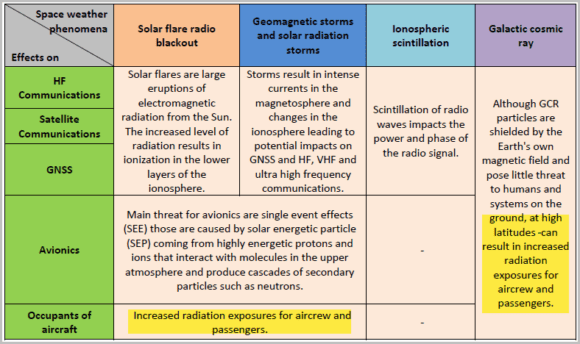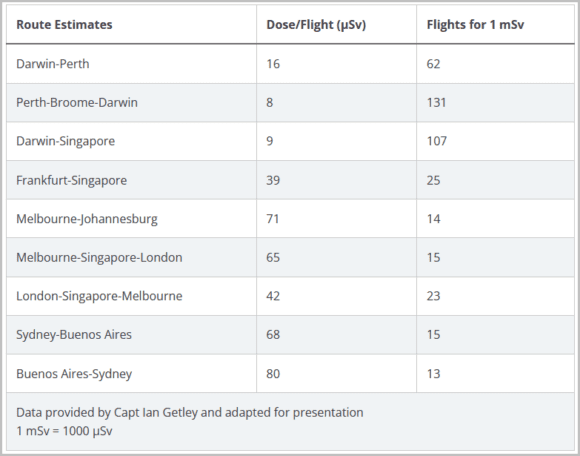
solar radiation 1140x640 1
Cosmic Radiation? Yes in case you didn’t know there is such a thing. The IAEA link says we should not be worried. But if you’re reading this you surely have an elevated interest in aviation, and there’s an aviation angle you want to know about. The IAEA article goes on to state: “passengers are exposed to elevated levels of cosmic radiation, especially at higher altitudes and latitudes, the radiation they receive in one flight is quite insignificant. Aircrew and frequent flyers are exposed to higher levels of radiation doses from space, because of how often they fly. The crew on flights typically operating at low altitude, such as most propellant aircraft, will hardly exceed a dose of one millisievert per year. Crew serving on long-haul polar routes, though, might be exposed to an annual effective dose of up to six millisieverts.” For example flights from the Arabian Gulf to the US and Canadian west coast that fly north over the North Pole. Also flights to Hong Kong from the US east coast and eastern Canada.
What is a millisievert? The link points to an article stating: “The millisievert is the unit used for very low doses. For instance, humans are not very radioactive, but the dose resulting from the internal radioactivity of their bodies amounts to 0,25 millisievert or mSv. A dose of 1 mSv should not generate excessive anxiety. Effects on human health are observed only beyond 100 mSv. It takes thousands of millisieverts dose to cause injuries that can be fatal in the short term.”
This useful chart is from the Australian Radiation Protection and Nuclear Safety Agency
EASA produced this chart early in 2021. We highlighted two areas that reinforce what you would expect.
Here’s what Eurocockit (The European Cockpit Association represents the collective interests of professional European pilots, has to say on cosmic radiation. Note especially this item: “All aeroplanes intended to be operated above 8.000 m (approx. 26.000 ft.) in polar/subpolar regions, especially long-range aircraft, should be equipped with a warning device to detect sudden increases in dose rate. During flight, the cockpit crew should have a warning function of the device plainly visible to allow timely response to sudden increases in the dose rates.” The mention of a warning device is noteworthy. But, of course, this is what pilots would like – it is not clear EASA requires this. Or any other regulatory body.
Well then, most of us need not have any concerns. The most at-risk group is aircrews flying over the poles. Also fighter pilots and astronauts.
Actually, the situation isn’t that clear. The National Institute for Occupational Safety and Health, part of the U.S. Department of Health & Human Services, offers some information. A key data point: “We don’t know what levels of cosmic radiation are safe for every person. And then The National Council on Radiation Protection and Measurements reported that aircrew have the largest average annual effective dose (3.07 mSv) of all US radiation-exposed workers. In 2018 Harvard published a study on flight attendants and cancer risk. The report states: “Compared to NHANES participants with a similar socioeconomic status (n = 2729), flight attendants (n = 5366) had a higher prevalence of every cancer we examined, especially breast cancer, melanoma, and non-melanoma skin cancer among females“. They conclude: “We observed higher rates of specific cancers in flight attendants compared the general population, some of which were related to job tenure.”
So maybe cosmic radiation should not be ignored. AOPA certainly thinks so and advises its members “…for those of us who make their living working on an aircraft, the conclusions offered by this paper are quite concerning.” The AOPA article notes “…bizjets will climb directly into the low 40s, and can eventually reach as high as 51,000 feet if the weather requires it. The trend with new business aircraft seems to be toward higher altitudes and longer ranges. While this capability is a boon for safety, it also means even greater exposure to radiation aloft. And as supersonic aircraft enter the inventory, it wouldn’t surprise me to see these airplanes cruising around 60,000 feet.”
So we can state with some confidence that flight crews are at elevated risk compared to the average air traveler. Frequent fliers experience elevated risks compared to the average traveler, but perhaps not as high as flight crew. Among flight crew, those working on business jets appear to be the most at risk since they fly the highest. The relationship between altitude and radiation was known a long time ago. Before the first World War, Victor Francis Hess observed that the radiation level at 5km above the Earth was about twice that of the radiation at sea level. Essentially, an aircraft flying at an altitude of about 25,000 ft exposes a person to about 10 times greater than at sea level. On aircraft with a typical cruising altitude of around 40,000 ft, radiation exposure is about 40 to 50 times greater than exposure at sea level.
Here is another interesting chart from the Australian Radiation Protection and Nuclear Safety Agency. The flight length and routing near the poles increase radiation exposure. Which underscores why flight crews can be considered radiation workers. The FFA published a paper on cosmic radiation some time back. The FAA recommended limit for an aircrew member is a 5-year average effective dose of 20 millisieverts per year, with no more than 50 millisieverts in a single year. A flight between Australia and Argentina could potentially be flown by a crew once per month and attract a 1 mSv dose after a year.
The FAA study further states: “Genetic defects passed on to future generations are a possible consequence of exposure to ionizing radiation. A child is at risk of inheriting genetic defects because of radiation received by the parents before the child’s conception. Suppose one of the child’s parents worked 700 block hours per year for 5 years flying between New York, NY, and Chicago, IL before the child was conceived. As in the previous example, the effective dose of galactic cosmic radiation received by the parent is assumed to be 0.0039 millisieverts per block hour. In 5 years, the dose to the parent would be 14 millisieverts.”
Then they add: “As seen in Table 4, with a parental dose of 14 millisieverts between 1 in 25,000 (0.004%) and 1 in 13,000 (0.008%) first-generation children would be expected to inherit one or more radiation-induced severe genetic defects. In the general population, 2-3% of liveborn children have one or more severe abnormalities at birth” Flight crews have been managing around this issue for years. But the problem is growing. France’s Institut de Radioprotection et de Surete Nucleaire reported that commercial airline flight personnel are the second most vulnerable worker category to radiation exposure after people making nuclear fuel.
Flight crews have been managing this issue for years. But the problem is growing. France’s Institut de Radioprotection et de Surete Nucleaire reported that commercial airline flight personnel are the second most vulnerable worker category to radiation exposure after people making nuclear fuel!
In April EASA added this Safety Information Bulletin on the issue. It states: “Solar radiation storms, occurring under particular circumstances, cause an increase in radiation dose to flight crews and passengers. As high polar latitudes and high altitudes have the least shielding from the particles, the threat is the greatest for executive jet and higher altitude commercial polar flights. Operators are already required to monitor the occupational exposure of aircrew to cosmic radiation (refer to Council Directive 2013/59/Euratom on ionising radiation).”
This builds well on The Air Navigation (Cosmic Radiation: Protection of Air Crew and Space Crew and Consequential Amendments) Order 2019 from the UK. There’s a lot to unpack in this document but here’s a part that operators need to pay attention to:
“Offences and penalties
- — (1) A person who contravenes a provision specified in the table in paragraph (2) is guilty of an offence and liable—
(a) on summary conviction—
(i) in England and Wales, to a fine; or
(ii) in Scotland or Northern Ireland, to a fine not exceeding the statutory maximum; or
(b) on conviction on indictment, to a fine or to imprisonment to a term not exceeding two years, or to both.”
From an airline Operations Manual we learn this: “Drawing on the measurements and evaluation of an EU research programme, for flights at temperate latitudes at a typical altitude of 35,000 ft, and for average solar activity, the effective dose rate is about 5 to 6 micro Sv per hour, and therefore a total time at altitude of about 200 hours is needed to accumulate 1 mSv. Near the equator at this altitude, the time needed is about 400 hours. At an altitude of 39,000 ft these times are about 150 and 300 hours respectively, and at an altitude of 33,000 ft, about 250 and 500 hours respectively. For example, a flight from northern Europe to the eastern seaboard of the USA will result in a value of an effective dose of about 30 to 40 micro Sv. For a longer flight from northern Europe to Japan, the total effective dose is about 50 to 70 micro Sv.”
If the case for cosmic radiation monitoring on aircraft is so self-evident, why don’t we hear more about this? Knowing that airlines and aircraft operators only install equipment following regulations, why are regulations so spotty? Crucially, how expensive is this monitoring equipment?
Star Navigation Inc. is a Canada-based flight sciences supplier. Their CEO Amir Bhatti believes his firm could supply its Cosmic monitoring system for under $5 – typically a 200 seater aircraft flying 200 flights per year could see an annual cost of around $4.80 per passenger, with costs dropping off quickly in succeeding years. As a passenger would you be willing to pay that to know your exposure level is being monitored and kept at a minimum? How might the crew feel, since they spend more time aloft than any traveler?
Now take the example of a business jet crew and its VVIP passengers. A typical flight from London to New York takes about seven and half hours. These aircraft get to FL400 within 15 minutes from takeoff. FlightRadar24 advises these flights are at FL400 or higher for six and a quarter hours. as stated above – On aircraft with a typical cruising altitude of around 40,000 ft, radiation exposure is about 40 to 50 times greater than exposure at sea level. We wonder if VVIPs flying these aircraft have any idea of the cosmic radiation they are being exposed to? Especially women who are expecting or want to have children. Commercial airliners are expected to deliver 30 to 40 micro SV, and on a business jet, it will be higher than that, 40 to 50 times more than at sea level as noted above.
Absent a regulation, business jet OEMs are not going to install the monitoring devices. And the same applies to commercial airliners. Do we need regulators to step up? Most probably because flights are getting longer.
Conclusions
- Although Cosmic Radiation is a well understood and documented issue, the lack of hard rules and common standards has not worked well to protect flight crews.
- The use of computer software to estimate crew exposure levels is likely inadequate.
- It is not clear that any airline or operator has installed radiation monitoring equipment.
- It is not clear that VVIPs flying in business jets realize they are exposed a lot more than regular air travelers. Flying at much higher altitudes business jet crews and passengers are exposed to higher levels of Cosmic radiation. These aircraft are probably the most in need of radiation monitoring equipment.
Views: 155







